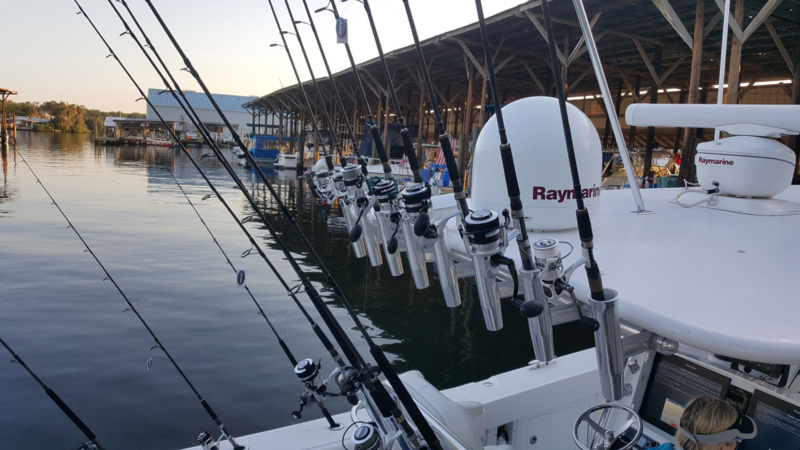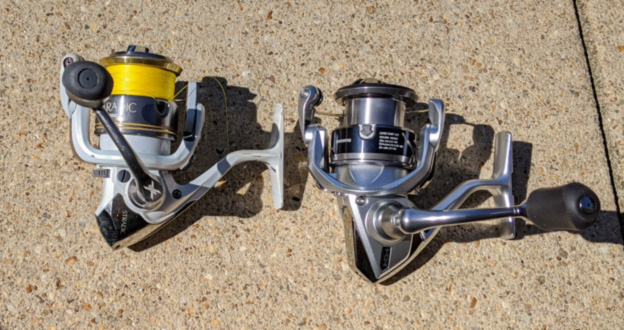Anglers could argue all day over what is the best fishing line. I’m a light tackle fisherman, and I only fish with spinning reels. The reels I use are 1000, 2500, or 3000 sizes. When I started fishing decades ago I spooled up with inexpensive monofilament line, but over the years have tried several brands of braid line and now have all of my spinning reels spooled with the same brand of 10-pound test braid. I like the consistency and not having to buy many different types of line. Spooling with braid, however, can be problematic. The spools on most spinning reels are made of smooth metal. Shortly after I tried braid line on my first reel, I snagged something on the bottom, and was winding a lot but could not gain line. I looked at the reel and realized that the entire bundle of line was rotating around the smooth spool.

There are several ways to deal with this. Some anglers are reluctant to fill their entire spool with braid (as it’s more costly than mono). They fill some portion of the spool with less expensive mono backing, then fill the rest of the spool with braid. I tried that in the past and while it does prevent the line from sliding on the spool, on occasion the knot linking the two types of line can work its way into a spot that grabs the outgoing line on a cast. I find that very annoying, as any angler will.
My alternative is to fill the entire spool with braid, after attaching a strip of masking tape onto the spool. The first few wraps of braid can dig into the tape and this keeps the bundle of line from rotating on the smooth metal. A few years ago, I was away from home and had to respool a reel but didn’t have any masking tape with me. I took two Band-Aids from my travel kit and used them to cover the metal surface on the spool — a trick which worked great.
Braid line holds up well over time and is not weakened by exposure to sunlight to the extent that mono line is. Wind knots, snags, or frequent retying of lures will, however, eventually shorten the total line length. One of the nicknames for the State of Maryland is the “Old Line State.” As a Marylander, I like my old line and I leave the braid on my spools until the total length of line is insufficient to make a long cast. When my reels reach that point, one way of dealing with it is to tie on an extra length of braid. But that creates the same knot problem I described earlier, so I prefer to remove the old, too-short section of braid and tie a fresh batch of braid directly to the tape-coated spool. With a little forethought, however, you can put that old line to new use.

Recently two of my reels, a 1000 size and a 2500 size, reached the point where the line was not long enough. Rather than stripping the remaining line off of both reels and replacing it with new, I removed the line from the 1000 size reel and discarded it. I then tied the end of the line from the 2500 reel onto the empty spool of the 1000 reel, and wound the line on. I left both reels in place on the rods, ran the line through all the guides, and applied some tension to the incoming line to get it packed tightly on the reel. Although the line was too short for the 2500 spool, it filled up the 1000 spool nicely. And with that, this article has reached the end of the line.
-By John Veil
Line Spooling Tips
(By Staff)
As you choose and spool up with braid line, always remember:
- When you’re spooling up, more pressure is more better. If the line goes onto the spool loose, taunt line will dig into the loose line when you have a heavy fish on. Massive tangles are the usual result.
- BUT… wear gloves if you’re going to apply that pressure by hand, because reeling braid line quickly between your tightly pinched fingers can actually create enough friction to burn you.
- If you’re spooling a number of rods and often fish with a lot of people, consider using a high-vis line color. That makes it much easier to keep tabs on everyone else’s lines, and see when they get crossed.
- You’ll want the spool completely filled to maximize casting distance, but remember that loops of line will spill off of over-filled reels. If you do over-fill and have loops sliding over the spool consider clipping off 10 or 15 yards, or more as necessary.
- Which brand of braid is best? We could argue about that all day but note that all of them are made of either Spectra (a Honeywell product) or Dyneema (made by DSM in the Netherlands), and both of these are gel-spun polyethylene with virtually identical properties. The way the lines are braided does influence how they feel and some brands braid together higher numbers of thinner fibers (smoother but more subject to abrasion damage) versus lower numbers of thicker fibers (more rope-like). But when all is said and done, most braid brands are amazingly similar to one another.